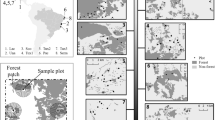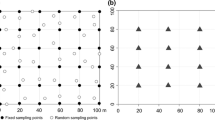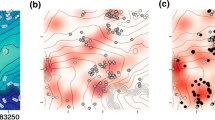Abstract
Tropical forests account for more than half of the global carbon forest stock and much of the biological diversity on Earth. However, disturbances such as deforestation and forest degradation threaten the maintenance of these ecosystem services. This study aimed to understand how different disturbance histories affect the forest stand biomass, as well as species and functional diversity, and to what extent these differences can change the relationships between biomass and their drivers. We used data from forests with clear-cut and selectively logged disturbance histories, and from old-growth forests, situated in the Brazilian Atlantic forest. Forests with logging disturbances showed significant losses in their aboveground biomass compared to those of old-growth forests (50% loss in selectively logged forests and 80% loss in clear-cut forests). Interestingly, only clear-cut secondary forests showed differences in species and functional diversity, and were dominated by species with acquisitive trait values, commonly found early in succession. Shifts in stand biomass drivers were observed in selectively logged forests. The mass-ratio hypothesis (mainly through the functional trait of maximum height) was the most important biomass driver in clear-cut secondary and old-growth forests, whereas the importance of the niche complementarity hypothesis (through functional richness and dispersion) was higher in selectively logged forests. Our study highlights that disturbance histories can affect forest aboveground biomass and its drivers. Moreover, our results reinforce the need for conservation of intact forests but highlight the importance of including degraded forests in conservation mechanisms based in carbon stocks, as these forests retain high values of species and functional diversities that are crucial to biomass and consequently carbon stock acquisition.




Similar content being viewed by others
References
Aide TM, Corrada-Bravo C, Campos-Cerqueira M et al (2013) Real-time bioacoustics monitoring and automated species identification. PeerJ 1:e103. https://doi.org/10.7717/peerj.103
Alkama R, Cescatti A (2016) Biophysical climate impacts of recent changes in global forest cover. Science 351:600–604. https://doi.org/10.1126/science.aac8083
Allan E, Manning P, Alt F et al (2015) Land use intensification alters ecosystem multifunctionality via loss of biodiversity and changes to functional composition. Ecol Lett 18:834–843. https://doi.org/10.1111/ele.12469
Asner GP, Rudel TK, Aide TM et al (2009) A contemporary assessment of change in humid tropical forests. Conserv Biol 23:1386–1395. https://doi.org/10.1111/j.1523-1739.2009.01333.x
Attri V, Pant KS, Dhiman R (2015) Effect of seed size and pre-sowing treatments on growth parameters and biomass of Sapindus mukorossi (Gaertn) seedlings under nursery condition. Environ Ecol 33:46–49
Baccini A, Walker W, Carvahlo L et al (2017) Tropical forests are a net carbon source based on new measurements of gain and loss. Science 5962:1–11. https://doi.org/10.1126/science.1252826
Barton K (2016) Package “MuMIn.”
Bates D, Maechler M, Bolker B et al (2014) Package “lme4.” 1–113
Bengtsson J, Angelstam P, Elmqvist T et al (2003) Reserves, resilience and dynamic landscapes. AMBIO A J Hum Environ 32:542–548. https://doi.org/10.1639/0044-7447(2003)032
Berenguer E, Ferreira J, Gardner TA et al (2014) A large-scale field assessment of carbon stocks in human-modified tropical forests. Glob Change Biol 20:3713–3726. https://doi.org/10.1111/gcb.12627
Berry NJ, Phillips OL, Ong RC et al (2008) Impacts ofselective logging on tree diversity across a rainforestlandscape: the importance of spatial scale. Landsc Ecol 23:915–929
Berry NJ, Phillips OL, Lewis SL et al (2010) The high value of logged tropical forests: lessons from northern Borneo. Biodivers Conserv 19:985–997. https://doi.org/10.1007/s10531-010-9779-z
Blaser J, Sarre A, Poore D and Johnson S (2011) Status of tropical forest management 2011. ITTO Technical Series No 38. International Tropical Timber Organization, Yokohama, Japan
Bretz F, Westfall P, Heiberger RM et al (2015) Package “multcomp.”
Burnham KP, Anderson DR (2002) Model selection and multimodel inference: a practical information-theoretic approach, 2nd edn
Burnham KP, Anderson DR, Huyvaert KP (2011) AIC model selection and multimodel inference in behavioral ecology: some background, observations, and comparisons. Behav Ecol Sociobiol 65:23–35. https://doi.org/10.1007/s00265-010-1029-6
Cardinale BJ, Wright JP, Cadotte MW et al (2007) Impacts of plant diversity on biomass production increase through time because of species complementarity. Proc Natl Acad Sci 104:18123–18128. https://doi.org/10.1073/pnas.0709069104
Carreño-Rocabado G, Peña-Claros M, Bongers F et al (2012) Effects of disturbance intensity on species and functional diversity in a tropical forest. J Ecol 100:1453–1463. https://doi.org/10.1111/j.1365-2745.2012.02015.x
Chave J, Coomes D, Jansen S et al (2009) Towards a worldwide wood economics spectrum. Ecol Lett 12:351–366. https://doi.org/10.1111/j.1461-0248.2009.01285.x
Chave J, Réjou-Méchain M, Búrquez A et al (2014) Improved allometric models to estimate the aboveground biomass of tropical trees. Glob Change Biol 20:3177–3190. https://doi.org/10.1111/gcb.12629
de Andrade RB, Balch JK, Parsons AL, Armenteras D, Roman-Cuesta RM, Bulkan J (2017) Scenarios in tropical forest degradation: carbon stock trajectories for REDD+. Carbon Balance Manage 12:1–7
FAO (2010) Global forest resources assessment 2010. America (NY) 147:350. ISBN: 978-92-5-106654-6
FAO and JRC (2012) Global forest land-use change 1990–2005
Fauset S, Gloor MU, Aidar MPM et al (2017) Tropical forest light regimes in a human-modified landscape. Ecosphere. https://doi.org/10.1002/ecs2.2002
Finegan B, Peña-Claros M, de Oliveira A et al (2015) Does functional trait diversity predict above-ground biomass and productivity of tropical forests? Testing three alternative hypotheses. J Ecol 103:191–201. https://doi.org/10.1111/1365-2745.12346
Floren A, Linsenmair KE (2005) The importance of primary tropical rain forest for species diversity: an investigation using arboreal ants as an example. Ecosystems 8:559–567. https://doi.org/10.1007/s10021-002-0272-8
Gibson L, Lee TM, Koh LP et al (2011) Primary forests are irreplaceable for sustaining tropical biodiversity. Nature 478:378–381. https://doi.org/10.1038/nature10425
Grace J, Mitchard E, Gloor E (2014) Perturbations in the carbon budget of the tropics. Glob Change Biol 20:3238–3255. https://doi.org/10.1111/gcb.12600
Grime JP (1998) Benefits of plant diversity to ecosystems: immediate, filter and founder effects. J Ecol 86:902–910. https://doi.org/10.1046/j.1365-2745.1998.00306.x
Harmon ME, Whigham DF, Sexton J, Olmsted I (1995) Decomposition and mass of woody detritus in the dry tropical forests of the northeastern Yucatan Peninsula, Mexico. Biotropica 27:305–316
Hijmans RJ, Cameron SE, Parra JL et al (2005) Very high resolution interpolated climate surfaces for global land areas. Int J Climatol 25:1965–1978. https://doi.org/10.1002/joc.1276
Hooper ER, Legendre P, Condit RS et al (2004) Factors affecting community composition of forest regeneration in deforested, abandoned land in Panama. Ecology 85:3313–3326. https://doi.org/10.1890/03-0655
IBGE (2012) Manual Técnico da Vegetação Brasileira
Jakovac CC, Peña-Claros M, Kuyper TW, Bongers F (2015) Loss of secondary-forest resilience by land-use intensification in the Amazon. J Ecol 103:67–77. https://doi.org/10.1111/1365-2745.12298
Kariuki M, Kooyman RM, Smith RGB et al (2006) Regeneration changes in tree species abundance, diversity and structure in logged and unlogged subtropical rainforest over a 36-year period SO FOREST ECOLOGY AND MANAGEMENT LA English DT Article DE chronological clustering; functional-group compositions 236:162–176
King DA, Davies SJ, Noor NSM (2006a) Growth and mortality are related to adult tree size in a Malaysian mixed dipterocarp forest. For Ecol Manage 223:152–158. https://doi.org/10.1016/j.foreco.2005.10.066
King DA, Davies SJ, Tan S, Noor NSM (2006b) The role of wood density and stem support costs in the growth and mortality of tropical trees. J Ecol 94:670–680. https://doi.org/10.1111/j.1365-2745.2006.01112.x
Kitagima K (2007) Seed and seedling ecology. In: Pugnaire FI, Valladares F (eds) Functional plant ecology, 2nd edn. CRC Press, New York, pp 549–580
Kuznetsova A, Brockhoff PB, Christensen RHB (2016) Package “lmerTest.”
Laliberté E, Legendre P, Shipley B (2015) Measuring functional diversity (FD) from multiple traits, and other tools for functional ecology. 1–28. http://cran.r-project.org/web/packages/FD/FD.pdf
Laurance WF, Nascimento HEM, Laurance SG et al (2006) Rapid decay of tree-community composition in Amazonian forest fragments. Proc Natl Acad Sci USA 103:19010–19014. https://doi.org/10.1073/pnas.0609048103
Lohbeck M, Poorter L, Mart M, Rodriguez J (2014) Changing drivers of species dominance during tropical forest succession. Funct Ecol. https://doi.org/10.1111/1365-2435.12240
Lohbeck M, Lebrija-Trejos E, Martínez-Ramos M et al (2015a) Functional trait strategies of trees in dry and wet tropical forests are similar but differ in their consequences for succession. PLoS ONE 10:1–15. https://doi.org/10.1371/journal.pone.0123741
Lohbeck M, Poorter L, Martinez-Ramos M, Bongers F (2015b) Biomass is the main driver of changes in ecosystem process rates during tropical forest succession. Ecology 96:1242–1252
Magnago LFS, Edwards DP, Edwards FA et al (2014) Functional attributes change but functional richness is unchanged after fragmentation of Brazilian Atlantic forests. J Ecol 102:475–485. https://doi.org/10.1111/1365-2745.12206
Magnago LFS, Magrach A, Laurance WF et al (2015a) Would protecting tropical forest fragments provide carbon and biodiversity cobenefits under REDD + ? Glob Change Biol 21:3455–3468. https://doi.org/10.1111/gcb.12937
Magnago LFS, Rocha MF, Meyer L et al (2015b) Microclimatic conditions at forest edges have significant impacts on vegetation structure in large Atlantic forest fragments. Biodivers Conserv 24:2305–2318. https://doi.org/10.1007/s10531-015-0961-1
Magnago LFS, Magrach A, Barlow J, Schaefer CEGR, Laurance WF, Martins SV, Edwards DP (2016) Do fragment size and edge effects predict carbon stocks in trees and lianas in tropical forests? Funct Ecol 31:542–552. https://doi.org/10.1111/1365-2435.12752
Marshall AR, Willcock S, Platts PJ et al (2012) Measuring and modelling above-ground carbon and tree allometry along a tropical elevation gradient. Biol Conserv 154:20–33. https://doi.org/10.1016/j.biocon.2012.03.017
Matos FAR, Magnago LFS, Gastauer M et al (2017) Effects of landscape configuration and composition on phylogenetic diversity of trees in a highly fragmented tropical forest. J Ecol 105:265–276. https://doi.org/10.1111/1365-2745.12661
Mensah S, Veldtman R, Assogbadjo AE et al (2016) Tree species diversity promotes aboveground carbon storage through functional diversity and functional dominance. Ecol Evol 6:7546–7557. https://doi.org/10.1002/ece3.2525
Metz B, Davidson O, Bosch P et al (2007) IPCC Climate Change 2007: mitigation of climate change. Cambridge University Press, Cambridge
Nicotra AB, Chazdon RL, Iriarte SVB (1999) Spatial heterogeneity of light and woody seedling. Ecology 80:1908–1926
Osuri AM, Sankaran M (2016) Seed size predicts community composition and carbon storage potential of tree communities in rainforest fragments in India’s Western Ghats. J Appl Ecol. https://doi.org/10.1111/1365-2664.12626
Peña-Claros M, Fredericksen TS, Alarcón A et al (2008) Beyond reduced-impact logging: silvicultural treatments to increase growth rates of tropical trees. For Ecol Manage 256:1458–1467. https://doi.org/10.1016/j.foreco.2007.11.013
Phillips OL, Martínez RV, Vargas PN et al (2003) Efficient plot-based floristic assessment of tropical forests. J Trop Ecol 19:629–645. https://doi.org/10.1017/S0266467403006035
Poorter L, Bongers F (2006) Architecture of 54 moist-forest tree species: traits, trade-offs, and functional groups. Ecology 87:1289–1301. https://doi.org/10.1890/0012-9658(2006)87
Poorter L, Rose SA (2005) Light-dependent changes in the relationship between seed mass and seedling traits: a meta-analysis for rain forest tree species. Oecologia 142:378–387. https://doi.org/10.1007/s00442-004-1732-y
Poorter L, Bongers F, Sterck FJ, Wöll H (2005) Beyond the regeneration phase: differentiation of height-light trajectories among tropical tree species. J Ecol 93:256–267. https://doi.org/10.1111/j.1365-2745.2004.00956.x
Poorter L, Mcdonald I, Alarcon A et al (2010) The importance of wood traits and hydraulic conductance for the performance and life history strategies of 42 rainforest tree species. New Phytol 185:481–492
Poorter L, van der Sande MT, Thompson J et al (2015) Diversity enhances carbon storage in tropical forests. Glob Ecol Biogeogr 24:1314–1328. https://doi.org/10.1111/geb.12364
Poorter L, Bongers F, Aide TM et al (2016) Biomass resilience of neotropical secondary forests. Nature 530:211–214. https://doi.org/10.1038/nature16512
Poorter L, van der Sande MT, Arets EJMM et al (2017) Biodiversity and climate determine the functioning of Neotropical forests. Glob Ecol Biogeogr 26:1423–1434. https://doi.org/10.1111/geb.12668
Prado-Junior JA, Schiavini I, Vale SV, Raymundo D, Lopes SF, Poorter L (2016a) Functional traits shape size-dependent growth and mortality 585 rates of dry forest tree species. J Plant Ecol 10(6):895–906
Prado-Junior JA, Schiavini I, Vale VS et al (2016b) Conservative species drive biomass productivity in tropical dry forests. J Ecol. https://doi.org/10.1111/1365-2745.12543
Putz FE, Zuidema PA, Pinard MA et al (2008) Improved tropical forest management for carbon retention. PLoS Biol 6:1368–1369. https://doi.org/10.1371/journal.pbio.0060166
Putz FE, Zuidema PA, Synnott T et al (2012) Sustaining conservation values in selectively logged tropical forests: the attained and the attainable. Conserv Lett 5:296–303. https://doi.org/10.1111/j.1755-263X.2012.00242.x
R Core Team (2015) R: a language and environment for statistical computing. R foundation for statistical computing, Vienna, Austria. http://www.R-project.org/
Rozendaal DMA, Chazdon RL (2015) Demographic drivers of tree biomass change during secondary succession in northeastern Costa Rica. Ecol Appl 25:506–516. https://doi.org/10.1890/14-0054.1
Ruiz-Jaen MC, Potvin C (2011) Can we predict carbon stocks in tropical ecosystems from tree diversity? Comparing species and functional diversity in a plantation and a natural forest. New Phytol 189:978–987. https://doi.org/10.1111/j.1469-8137.2010.03501.x
Saatchi SS, Harris NL, Brown S et al (2011) Benchmark map of forest carbon stocks in tropical regions across three continents. Proc Natl Acad Sci. https://doi.org/10.1073/pnas.1019576108
Tabarelli M, Peres Ca (2002) Abiotic and vertebrate seed dispersal in the Brazilian Atlantic forest: implications for forest regeneration. Biol Conserv 106:165–176. https://doi.org/10.1016/S0006-3207(01)00243-9
Tilman D (1999) The ecological consequences of changes in biodiversity: a search for general principles. Ecology 80(5):1455–1474
Toledo M, Poorter L, Peña-Claros M et al (2011) Climate is a stronger driver of tree and forest growth rates than soil and disturbance. J Ecol 99:254–264. https://doi.org/10.1111/j.1365-2745.2010.01741.x
UNFCCC (2008) Report of the conference of the parties on its thirteenth session, held in Bali from 3 to 15 December 2007. FCCC/CP/2007/6/Add.1*. FCCC/CP/2007/6/Add1* 1–60. https://doi.org/10.1016/j.biocon.2006.08.013
UNFCCC (2015) Conference of the parties on its twenty-first session, held in Paris from 30 November to 13 December 2015. Addendum-Part two action Tak by Conf Parties 1194:1–36
Weiher E, Clarke GDP, Keddy PA et al (1998) Community assembly rules, morphological dispersion, and the coexistence of plant species. Oikos 81:309–322
Wickham H, Chang W (2016) Package “ggplot2.”
Zanne AE, Lopez-Gonzalez G, Coomes DA et al (2009) Global wood density data-base. Dryad. http://hdl.handle.net/10255/dryad.235
Acknowledgements
We thank Chong Kwek Yan and two anonymous reviewers for comments that greatly improved the article. We also thank Érica R. Borges for assistance in map creation, Conselho Nacional de Desenvolvimento Científico e Tecnológico (CNPq, Project Numbers 446698/2014-8 and 307591/2016-6) and FAPEMIG (APQ-01309-16, and PPM-00584-16) for grants. JAAMN holds a productivity fellowship of CNPq. JAPJ was funded by Coordenação de Aperfeiçoamento de Pessoal de Nível Superior (CAPES) and CNPq (Project Number 441225/2016-0).
Author information
Authors and Affiliations
Corresponding authors
Additional information
Communicated by David Hawksworth.
This article belongs to the Topical Collection: Forest and plantation biodiversity
Electronic supplementary material
Below is the link to the electronic supplementary material.
Rights and permissions
About this article
Cite this article
Pyles, M.V., Prado-Junior, J.A., Magnago, L.F.S. et al. Loss of biodiversity and shifts in aboveground biomass drivers in tropical rainforests with different disturbance histories. Biodivers Conserv 27, 3215–3231 (2018). https://doi.org/10.1007/s10531-018-1598-7
Received:
Revised:
Accepted:
Published:
Issue Date:
DOI: https://doi.org/10.1007/s10531-018-1598-7




